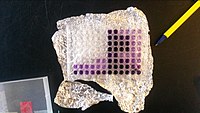Bicinchoninic acid assay

Imagine you are trying to bake a cake and you need to know how much sugar you have. But the sugar looks the same as the flour and you can't tell them apart just by looking at them. So you need a special test to check how much sugar you have.
That's what scientists need too - they need to measure how much protein is in a sample, but they can't just look at it and tell. So they use a special test called the bicinchoninic acid assay, or BCA for short.
Here's how it works:
1. First, scientists mix a small amount of the sample with a special solution that has bicinchoninic acid in it.
2. The bicinchoninic acid reacts with the proteins in the sample, forming a new substance that has a different color.
3. The more protein in the sample, the more of this new colored substance is formed.
4. Scientists can then use a special instrument called a spectrophotometer to measure how much color there is in the sample. This tells them how much protein was in the sample to begin with.
So, just like the sugar and flour in our cake example, the bicinchoninic acid test helps scientists measure how much protein is in their sample even if they can't see it with their eyes.
That's what scientists need too - they need to measure how much protein is in a sample, but they can't just look at it and tell. So they use a special test called the bicinchoninic acid assay, or BCA for short.
Here's how it works:
1. First, scientists mix a small amount of the sample with a special solution that has bicinchoninic acid in it.
2. The bicinchoninic acid reacts with the proteins in the sample, forming a new substance that has a different color.
3. The more protein in the sample, the more of this new colored substance is formed.
4. Scientists can then use a special instrument called a spectrophotometer to measure how much color there is in the sample. This tells them how much protein was in the sample to begin with.
So, just like the sugar and flour in our cake example, the bicinchoninic acid test helps scientists measure how much protein is in their sample even if they can't see it with their eyes.
Related topics others have asked about:
